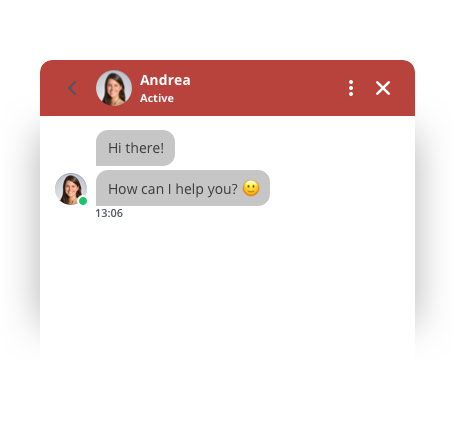
7 Tips & Tools for Personal Connections with Customers
Most companies' customer communication operates on a ticket-in-ticket-out basis . Personal communication is sacrificed for efficiency in the form of automated emails, support tickets and voice-activated phone menus.
Yet, connecting with your customers on a personal level pays off. Research shows that emotionally connected customers are twice as loyal as merely satisfied ones and they generate more profit in the long run.
People will forget what you said, people will forget what you did, but people will never forget how you made them feel.
Maya Angelou![]()
Here's how to create personal connections with your customers in the digital age.
1
Self-disclosure
Many customer service emails read as if they were written by robots. The customer is often not addressed by name, and emails are signed with the department name: “Regards, [Company] team” instead of "Regards, Bob/Joe/whoever" .
If you want to bond with your customers, sharing some personal information is crucial. Transparency shows your customer that your business is not just another faceless entity. It builds trust.
That’s why we encourage our customers’ service agents to use their name and a real profile picture when chatting to customers.


Besides chat conversations, the ‘About Us’ page on your website can also be used to introduce your team and tell your story. When a customer wants to learn more about the business behind the product, that’s the page they’ll first come across.
Many companies try to appear overly professional with a corporate description of their company. But this comes across as stiff and will likely bore your visitor. Instead, you’ll emotionally connect with your customers if you share stories about your team or your company.
Sharing stories (and hardships) makes you personable and relatable. For example, Yellow Leaf Hammocks touches visitors’ hearts with its stories of empowering artisan weavers and their families.
Another way to connect with your customers is via your blog. A blog with extensive sections on workplace practices, like the Buffer Blog , shows your customers what it’s like behind the scenes.
At Userlike, we aim to be a transparent company, so our customers can meet the team behind the scenes on our team page and get a glimpse of our culture on our Instagram page . These are also great resources for applicants to get a sense of your company culture.
2
Know your customers
Knowing your customers is just as important as self-disclosure. Your customers are individuals, each with different needs, desires and frustrations.
As 95% of customers make purchasing decisions based on emotions , it makes sense to gain a deeper understanding of your customers beyond the surface level.

Understanding your customers means you’ll be able to serve them better and offer more bespoke solutions to their problems.
A few ways to get to know your customers:
Interviews. Interviewing your customers in a one-to-one setting allows you to dig deeper. The key is to make your interview more like a conversation that will help your customers feel relaxed enough to trust you with their innermost feelings.
Hosted dinners. Meeting your customers in person can reveal invaluable insights. At Userlike, we host dinners to get to know our customers in relaxed and informal settings. Good food and wine help break the ice and stimulate open conversations about a wide range of topics.
Social media groups. Creating a group for your customers gives them a forum to openly discuss needs and wants. Interactions tend to be more informal on social media, which gives you the opportunity to get to know your customers on a more personal level.
3
Make your digital space inviting
How you welcome customers into your digital space sets the tone for your relationship with them. When you first meet someone, you judge them based on what they’re wearing. And it’s no different when you visit a website.

The color , font and images used on your website reflect your brand. While beauty is in the eye of the beholder, cluttered or visually unappealing websites will detract from the user experience and lead them to other businesses.
Also the language you use gives your customers a taste of what to expect when doing business with you. Companies often use technical terms to explain their products’ features, but this tends to alienate customers. Instead, to keep your customers interested, you’d do better taking a benefits-focused approach .

Looking for better customer relationships?
Test Userlike for free and chat with your customers on your website, Facebook Messenger, and Telegram.
Read moreWhen you write about your product with your customers and their needs at the forefront, they’ll likely be more receptive to what you have to say.
For example, Mailchimp’s landing page crystallizes the benefits of their email marketing software for the reader:

Not only does the you-focused approach feel addressed to the reader, but it’s instantly clear how Mailchimp can benefit them.
4
Customer value alignment
Customers are drawn to businesses that share their values. According to research by the Harvard Business Review, shared values are the primary drivers behind brand relationships with the few customers who want them.
Shared values are about your principles and ethics; what you stand for. They form the basis of most relationships. By aligning your business with your customers’ values, you show your customers that you’re on their level and you’re just like them.
For example, Levi Strauss addresses the world’s water shortage in the production of its jeans. The company also supports vulnerable communities in more than 100 countries.

You don’t need to save the world, but showing your customers that you stand for something other than money creates the conditions for long-lasting loyalty. 6Q provides examples to get you started.
5
Use personal communication channels
How personal your customer service interactions are, largely depends on the communication channels used. Next to face-to-face communication, the phone adds a human touch to interactions. Most customers, however, don’t enjoy being placed on hold. It’s also inefficient for businesses as agents can only take one call at a time.

Email can provide a bit of breathing space for the customer and the business, but it can feel impersonal and one-sided, especially if responses take days.
Mobile messaging and website chat, on the other hand, offer a personal experience without compromising on efficiency. Which is why at Userlike we've built our solution around these channels.
For a deeper dive into these and other customer channels, check out our article The 9 Customer Channels – Strengths and Weaknesses.
6
Hire for interpersonal skills
Interpersonal skills can be developed, but delivering personal customer service is easier if agents don’t have to engage in too much emotional labor and come to the table with the desired skills and traits :
Listening. Most people treat conversations like a competitive sport where we’re mostly waiting to have our say or to point out flaws in the other person’s argument.
This dilutes our attentiveness and we end up missing important information. In customer service, listening is crucial for understanding how your customers tick.
Most people do not listen with the intent to understand; they listen with the intent to reply.
Stephen R. Covey![]()
Empathy/compassion. Empathy plays a significant role in building personal connections with your customers. Putting yourself in your customer’s shoes allows you to understand them better and bend the rules when there are edge cases. It also helps you tailor solutions, as previously mentioned.
Charisma. Charismatic people are likable. They’re the people who light up a room as soon as they enter. People are drawn to charismatic people, which is what makes them an asset in your support team.
Contrary to popular belief, charisma is not a trait people are inherently born with. It can be developed like any other skill, as Olivia Fox Cabane argues in The Charisma Myth . She breaks down charisma into the following components which can be applied to customer service:
- Presence — giving your full attention to your customer without interrupting or multi-tasking makes them feel heard.
- Power — conveys confidence in the customer that you know what you’re doing.
- Warmth — this conveys goodwill to others. This means finding the best solution for your customer, even if it goes against policies.
7
Use rapport-building techniques
Teaching your frontend reps how to build rapport with your customers helps them to connect with them on a personal level. Rapport is the sense of feeling you get you’re on the same wavelength as someone. When your customers feel understood, they’ll be more receptive to what you have to say.
Rapport-building doesn’t come naturally to everyone, so here are some powerful tips for building rapport with your customers to get you started:
Mirroring. This is based on the principle that people like people like themselves. You can quickly develop a rapport with your customer by adopting their verbal and physical behaviors.
This may sound a little creepy but mirroring someone’s body language and tone signals that you’re on the same level as them. It sends the message that you’re paying close attention to them.
While imitation is the sincerest form of flattery, it can also backfire. As a rule-of-thumb: don't mirror negative vibes to prevent your conversation from spiralling downwards.

Finding common ground. This is one of the easiest ways to build a rapport with someone. We all do this when we first meet a new acquaintance or colleague. Topics such as the weather or trending TV series are ice-breakers and help us overcome social inhibitions.
To find common ground with your customers, practice active listening, so you can pick up on anything that might spark a conversation — holidays, interests, etc. Of course, a conversation is a two-way street, so opening up yourself can help break the ice with a reserved customer.
This is what is called the law of self-disclosure, by the author of The Like Switch . But this is not carte blanche to reveal your deepest, darkest secrets. Stick to safe topics to avoid blurring boundaries.
For more tips on this topic, check our article 11 Powerful Tips for Building Customer Rapport.
Customers buy from businesses they can relate to. If you treat your customers like support tickets, you miss out on the opportunity to get closer to them.
Connecting with your customers on a personal level boosts retention rates and yields insights which allow you to serve them better.
All things being equal, people will do business with, and refer business to, those people they know, like and trust.
Bob Burg![]()




